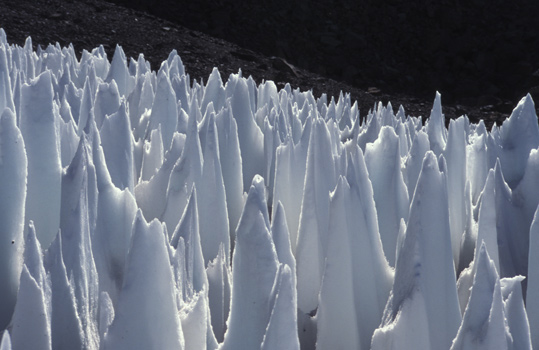
Penitentes Photo Credit: Wikipedia Digital Commons
Aminiel Nnko and I summited Kilimanjaro on November 9, 2020 at 8:26 a.m. This was Aminiel's first summit and my fifth. Before the summit, we leisurely hiked and camped around the North side of Kilimanjaro. Those days were warm, the nights frosty, with just a little rain now and again. We saw no other people on the Northern side which was a new and pleasant way to experience the mountain. But for a rougher than normal summit, it was a great hike.

Aminiel Nnko -Uhuru Peak-November 9, 2020. Photo: Wil Smith
Summit Day
Summit day was harsh. We left School Hut Camp (15,748 ft.) at midnight. At first, conditions looked good: clear skies, no wind, relatively warm. But as we climbed higher up the scree, the wind kicked up, a dreadful fog overtook us and the cold was sub-zero. We got to Gilman's Point on the crater rim at dawn (18, 885 ft.) By then, the cold wind was howling. We were dressed warm enough, except Ammy wore only a porous wool hat with no hood for a windbreak. A hypothermic brain didn't seem like a good idea, so we improvised a cranial windbreak out his nylon sun hat. Not ideal, but suitable for survival purposes.
On a fairer day, the summit of Uhuru Peak (19,341 ft.) would be just an hour or so uphill from Gilman's Point. But, this day it seemed more like eternity. About half way up we met a bleary eyed exhausted group of twenty-somethings on their way down. These were the first other climbers we'd seen all week, but there were no greetings. A porter was holding up one of the women, her arm slung over his shoulder. She was staggering and looked about to faint. The wind was freezing faces. Nobody said anything. We just huffed, puffed and miserably glanced at each other as we passed.
The Penitentes
Visibility was near nothing when we were halted by at field 0f of vertical ice blades poking up like punji sticks in a pit trap. I hadn't seen this on Kilimanjaro before, nor anywhere else. Thoughtlessly, I followed our young guide in trying to maneuver through this medieval looking mess. The wind was blowing harder, the fog was getting thicker, and it was...well...scary. We were soon stranded in the midst of these razor looking ice spikes.
Wangaeli Saves the Day
Fortunately one of our most seasoned porters Wangaeli Kitomary had decided to follow us on this venture. Wangaeli is in his fifties and tough as a rock from carrying 20 kilo loads up Kilimanjaro for decades. He explained to Aminiel in Swahili that he'd seen these ice things once before and while you can't climb through them, there is a way to circumvent them by cutting close to the crater's edge. Wangaeli got the guide and me out of the trap, got all of us reorganized, and led us all around the blades so we could find our way to the summit. With Wangaeli at the helm, we finally heaved up to the summit, took some hasty photos, and beat tracks out of there.
The Northern Route is Best
We made it back with no harm done. The good news is that the 10-day Northern route around Kilimanjaro is the best way to get pole pole (slowly slowly) acclimatized to Kilimanjaro's gnarly altitude. After spending several days in the 12, 13, 14 and 15,000 foot altitudes, neither Aminiel or I felt any appreciable ill effects from the altitude when popping up the 19,000 feet. On my past climbs, I had always suffered from nausea, headache, trouble sleeping and a general sick feeling, not unlike a days long hangover. This time, other than a loss of appetite for the camp food, I felt great--wind, rain fog and snow notwithstanding.
Another interesting aspect of this trip is the only training Aminiel and I did was daily walking. For four weeks before the climb we walked from 10-15 kilometers around Usa River everyday. Toward the end we started adding weight to our backpacks. Before past climbs I had trained a lot harder, 10 kilometer runs, hiking fast uphill and lifting weights. I actually felt more fit this time around. It makes sense in a way. You don't run up Kilimanjaro--you walk--very slowly. Perhaps the best way to train for a walk is to walk.
Back to the Lowlands
After a quick bit of Google research, I'm able to add a name to those creepy ice spikes: pententes. Sometime in the past, they reminded someone of praying people doing penance. It's strange what too much altitude can do for the imagination. The Penitentes are exclusive to dry areas at very high altitudes. First described by Charles Darwin in 1839, they are more common in the Andes of South American. The points are directed toward the sun. Apparently they are rarely found on Kilimanjaro. I guess it was our lucky day.
